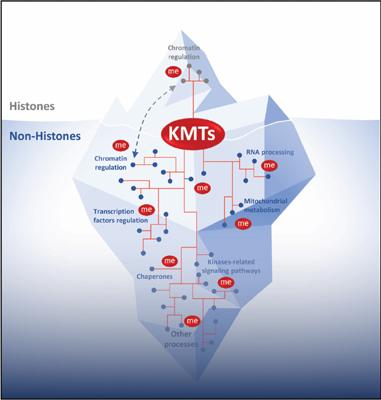Current Protein & Peptide Science ( IF 2.8 ) Pub Date : 2020-06-30 , DOI: 10.2174/1871527319666200102101608 Valentina Lukinović 1 , Alexandre G Casanova 1 , Gael S Roth 1 , Florent Chuffart 1 , Nicolas Reynoird 1

|
Protein lysine methylation is a functionally diverse post-translational modification involved in various major cellular processes. Lysine methylation can modulate proteins activity, stability, localization, and/or interaction, resulting in specific downstream signaling and biological outcomes. Lysine methylation is a dynamic and fine-tuned process, deregulation of which often leads to human pathologies. In particular, the lysine methylome and its associated signaling network can be linked to carcinogenesis and cancer progression.
Histone modifications and chromatin regulation is a major aspect of lysine methylation importance, but increasing evidence suggests that a high relevance and impact of non-histone lysine methylation signaling has emerged in recent years. In this review, we draw an updated picture of the current scientific knowledge regarding non-histone lysine methylation signaling and its implication in physiological and pathological processes. We aim to demonstrate the significance of lysine methylation as a major and yet underestimated posttranslational modification, and to raise the importance of this modification in both epigenetic and cellular signaling by focusing on the observed activities of SET- and 7β-strandcontaining human lysine methyltransferases.
Recent evidence suggests that what has been observed so far regarding lysine methylation’s implication in human pathologies is only the tip of the iceberg. Therefore, the exploration of the “methylome network” raises the possibility to use these enzymes and their substrates as promising new therapeutic targets for the development of future epigenetic and methyllysine signaling cancer treatments.
中文翻译:

赖氨酸甲基转移酶信号:组蛋白只是冰山一角。
蛋白质赖氨酸甲基化是涉及各种主要细胞过程的功能多样的翻译后修饰。赖氨酸甲基化可以调节蛋白质的活性,稳定性,定位和/或相互作用,从而导致特定的下游信号传导和生物学结果。赖氨酸甲基化是一个动态且微调的过程,其失调通常会导致人类疾病。特别地,赖氨酸甲基化组及其相关的信号网络可与致癌和癌症进展相关。
组蛋白修饰和染色质调节是赖氨酸甲基化重要性的一个主要方面,但是越来越多的证据表明,近年来非组蛋白赖氨酸甲基化信号的高度相关性和影响已经出现。在这篇综述中,我们绘制了有关非组蛋白赖氨酸甲基化信号传导及其在生理和病理过程中的涵义的最新科学知识的最新图片。我们旨在证明赖氨酸甲基化作为主要但仍被低估的翻译后修饰的重要性,并通过关注观察到的含有SET和7β链的人赖氨酸甲基转移酶的活性来提高这种修饰在表观遗传和细胞信号传导中的重要性。
最近的证据表明,到目前为止,关于赖氨酸甲基化在人类病理中的影响的观察仅是冰山一角。因此,对“甲基基因组网络”的探索增加了使用这些酶及其底物作为未来表观遗传和甲基赖氨酸信号治疗癌症发展前景的新治疗靶标的可能性。


























 京公网安备 11010802027423号
京公网安备 11010802027423号